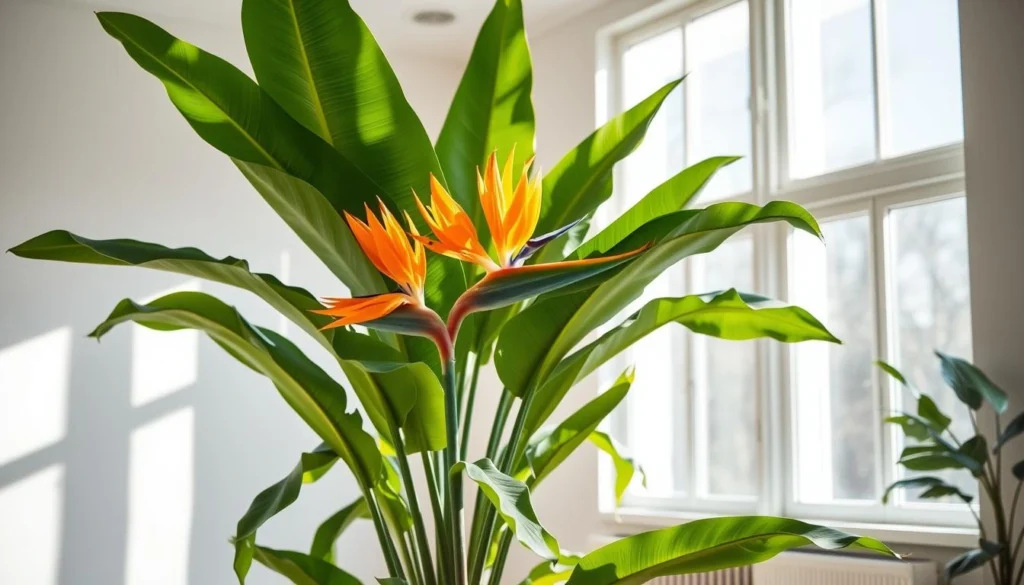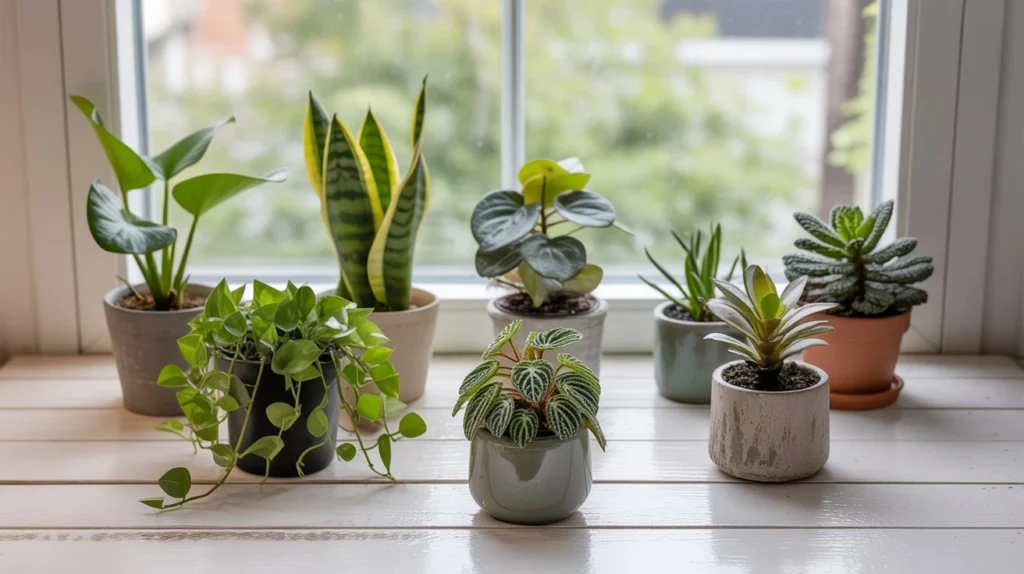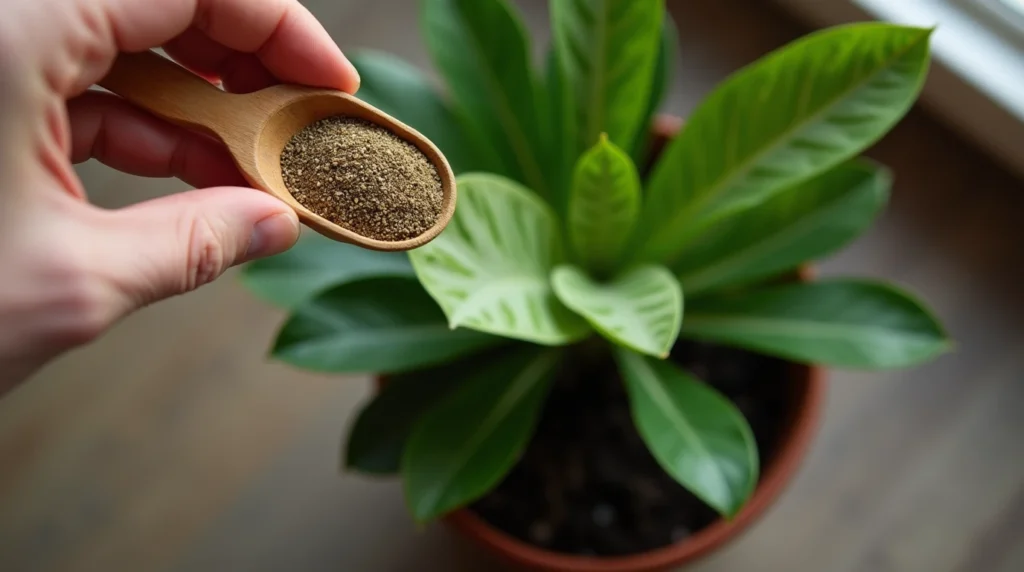
Did you know the tropical houseplant called Bird of Paradise comes from South Africa? It can even grow well indoors with the right care. Its bright orange and blue flowers make it a favorite for indoor gardening fans.
Having this exotic plant indoors can make any room look elegant. It’s easy to care for, making it perfect for beginners in indoor gardening.
Learning how to care for this tropical houseplant will let you enjoy its beautiful flowers and green leaves all year. In this article, we’ll give you tips on how to grow Bird of Paradise indoors.
Table of Contents
The Magnificent Bird of Paradise Indoor Plant
Looking for a unique plant for your indoor garden? The Bird of Paradise is a great choice. It’s a tropical houseplant with striking flowers and lush leaves. It’s a favorite among those who love indoor gardening.

Origins and Natural Habitat
The Bird of Paradise comes from South Africa. It grows near rivers, among shrubs. It loves full sun to partial shade and well-drained soil. Knowing where it comes from helps us create the right conditions for it indoors.
Popular Varieties for Indoor Growing
There are many Bird of Paradise varieties, like Strelitzia reginae, Strelitzia nicolai, and Strelitzia alba. The orange-flowered Strelitzia reginae and the giant white-flowered Strelitzia nicolai are favorites for indoor growing. They have unique features and are not too big.
Benefits of Growing Bird of Paradise Indoors
Growing Bird of Paradise indoors brings tropical elegance to your space. It also purifies the air and can lift your mood. It’s one of the best indoor plants for making your home or office better.
Essential Care Requirements for Tropical Success
To enjoy a thriving Bird of Paradise, you must replicate its natural habitat. Understanding and meeting its specific needs is key to success.
Light Requirements and Placement
Bird of Paradise plants need bright, indirect light to grow well. Place your plant near an east- or west-facing window for the best light. This avoids harsh direct sunlight that can burn leaves. Don’t put your plant in a dark spot, as it will grow weak and spindly.

Watering Schedule and Humidity Needs
Keeping your Bird of Paradise plant consistently moist is important. Water it well, letting the top inch of soil dry out before watering again. Also, a humid environment is beneficial. You can use a tray with water and pebbles or a humidifier nearby.
Soil Composition and Drainage
A well-draining potting mix is essential to avoid root rot. Mixes with perlite, vermiculite, or sand are good. They ensure good drainage and aeration. Don’t use regular garden soil, as it can cause drainage problems.
Temperature and Environmental Considerations
Bird of Paradise plants like temperatures between 65-80°F (18-27°C). Keep your plant away from drafts, air conditioning vents, and extreme temperatures. A stable temperature and a comfortable environment help your plant thrive.
Maintenance and Growth Management
To keep your Bird of Paradise healthy and blooming, follow these tips. Regular care is key for healthy growth and vibrant blooms.
Fertilizing Schedule and Requirements
Fertilize your Bird of Paradise in spring and summer. Use a balanced fertilizer (20-20-20). Dilute it to half strength to avoid root damage. Fertilize monthly and flush the soil with water to prevent salt buildup.
Pruning and Cleaning Techniques
Pruning and cleaning are important for your Bird of Paradise’s health and look. Remove dead or damaged leaves to stop disease and promote growth. Use sharp tools and clean the leaves with a damp cloth to keep them healthy.
Repotting Guidelines
Repot your Bird of Paradise every 2-3 years for fresh soil. Choose a pot only slightly larger than the old one. Use a well-draining mix and handle the roots gently to avoid shock.
Encouraging Your Bird of Paradise to Bloom Indoors
To get your Bird of Paradise to bloom indoors, give it enough light and keep the temperature between 65-75°F (18-24°C). Keeping it slightly pot-bound can also help. Avoid over-watering to prevent root rot and encourage blooming. Follow these tips to enjoy your Bird of Paradise’s blooms indoors.
Troubleshooting Common Problems
Bird of Paradise plants can face common issues. Knowing these problems and how to solve them is key to keeping your plant healthy and thriving.
Leaf Issues: Yellowing, Browning, and Curling
Leaf problems are common in Bird of Paradise plants. Yellowing leaves often mean you’re watering too much or too little. Check your watering schedule and make the needed changes. Browning leaf tips can signal low humidity or too much fertilizer. To fix this, boost the humidity or cut back on fertilizing.
- Check soil moisture before watering
- Increase humidity around the plant
- Adjust fertilization schedule
Pest Management and Disease Prevention
Pests like spider mites, mealybugs, and scale can harm your Bird of Paradise. Regularly check your plant for pests and treat them quickly with insecticidal soap or neem oil. Disease prevention is also vital; make sure your plant has good air flow and avoid too much water to prevent root rot.
Growth Problems and Solutions
If your Bird of Paradise isn’t growing well, it might need more light, better fertilization, or a bigger pot. Make sure it gets enough light, fertilize regularly when it’s growing, and repot it if it’s too small.
- Assess and adjust lighting conditions
- Fertilize with a balanced fertilizer
- Repot the plant if necessary
Read More :
Caring for Your Indoor Rubber Plant
Conclusion: Enjoying Your Tropical Indoor Oasis
Follow the care tips in this article to enjoy your bird of paradise indoor plant fully. It will make your home a beautiful and thriving oasis. These plants add elegance and many benefits, like purifying the air and looking great.
As you care for your Bird of Paradise, you’ll love having a tropical paradise at home. This plant will impress everyone and make you proud. With the right care, you’ll see its stunning blooms and lush leaves for many years.
FAQ
How often should I water my Bird of Paradise plant?
Water your Bird of Paradise when the top inch of soil is dry. This is usually once a week in summer and every 10-14 days in winter. This keeps the soil moist and prevents root rot.
What kind of light does Bird of Paradise need?
Bird of Paradise plants need bright, indirect light to grow and bloom. Direct sunlight can burn the leaves. Place them near an east- or west-facing window or use a sheer curtain to soften the light.
Why are the leaves on my Bird of Paradise turning yellow?
Yellow leaves can mean too much or too little water, or extreme temperatures. Check your watering, soil moisture, and the plant’s environment. This will help you find and fix the problem.
How can I encourage my Bird of Paradise to bloom?
For blooming, make sure it gets enough light, water it right, and keep it slightly root-bound. Fertilize during the growing season to help it grow and bloom well.
What is the ideal temperature for growing Bird of Paradise indoors?
The best indoor temperature for Bird of Paradise is 65-80°F (18-27°C). This temperature helps it grow and bloom well.
Can I grow Bird of Paradise outdoors?
Bird of Paradise can grow outdoors in warm, frost-free places. But, it’s often kept indoors in cooler areas. If you live in a frost-free zone, you can grow it outside in a shaded spot.
How often should I fertilize my Bird of Paradise plant?
Fertilize your Bird of Paradise in spring and summer with a balanced fertilizer. This helps it grow and bloom well.
What are some common pests that affect Bird of Paradise plants?
Spider mites, mealybugs, and scale are common pests. Check your plant often and treat any pests quickly to keep it healthy.

